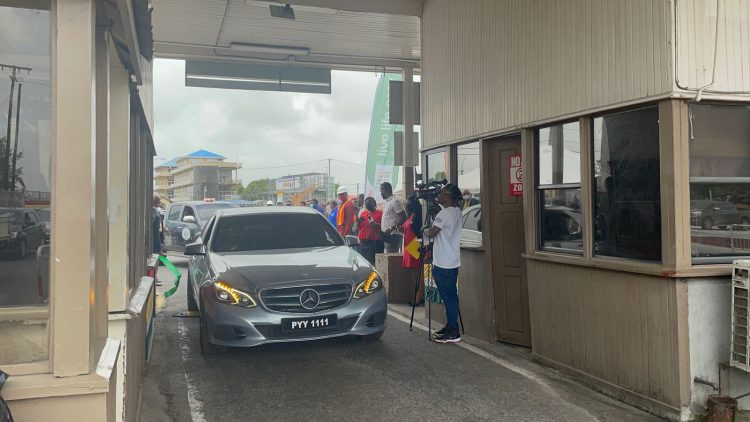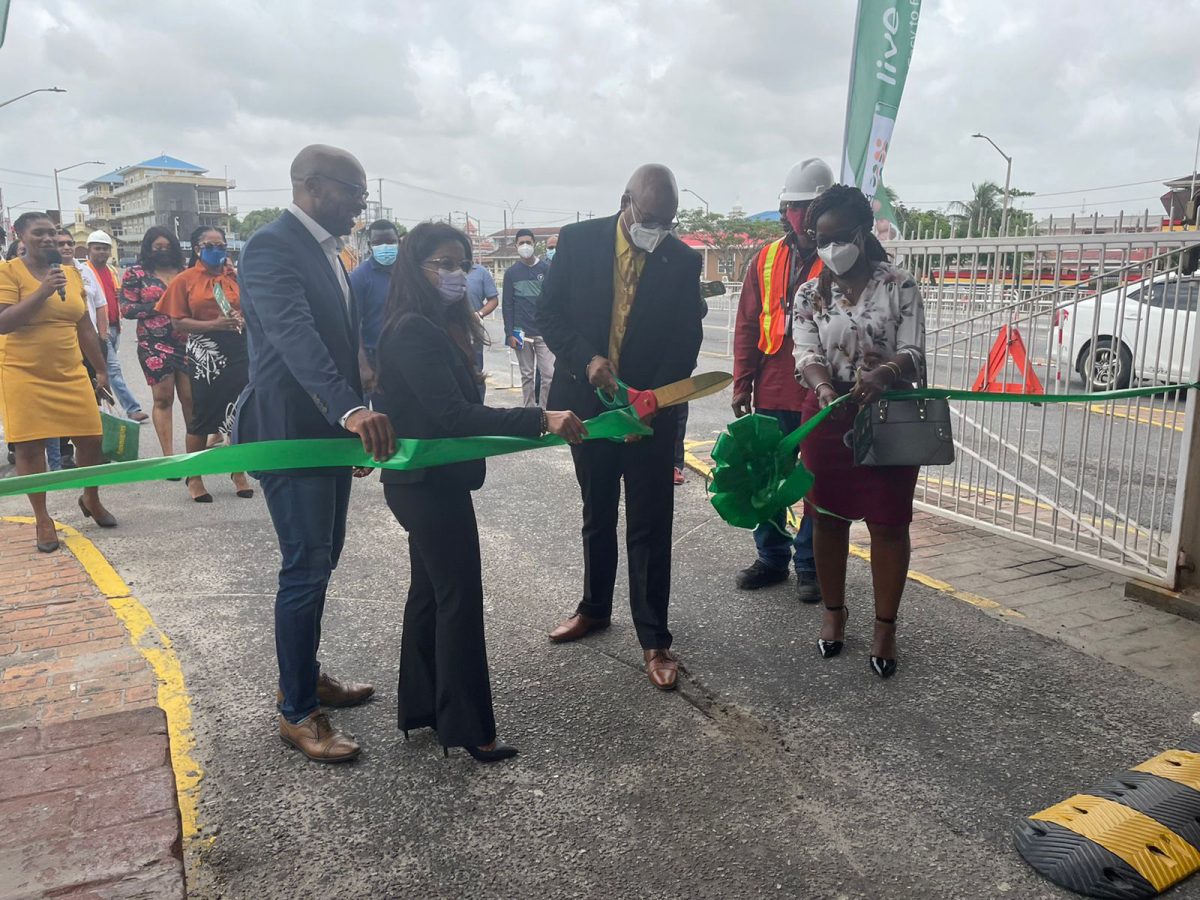The Demerara Harbour Bridge and the Ministry of Public Works will soon be engaged in constructing a bypass lane to further ease traffic congestion at the bridge, Minister of Public Works Juan Edghill yesterday said during the launch of the country’s only automated toll payment system.
The minister said that the lane will eliminate the need for bridge commuters heading to Georgetown to halt at the ‘T’ intersection before proceeding north on the East Bank Public Road.
“Very soon we will be able to implement a continuous left turn when you are heading east across the bridge… So rather than when you exit the bridge, heading east you have to wait on the traffic light, there will be a continuous slip lane that you can keep turning left,” Edghill disclosed before stating that they have already negotiated and received permission from the church, which is close by to the bridge’s access road, to remove a section of the fence and the traffic control block.

This latest development, he said, is a part of plans to improve traffic flow and ease congestion at the bridge.
The Minister also disclosed that they have introduced an emergency lane on the bridge that has been functioning even at peak hours.
He also noted that vendors and taxi operators have been removed from the verges of the bridge access roadway as they were also contributing to the traffic congestion.
The minister also stated that the partnership with Mobile Money Guyana (MMG) is aimed at improving financial accountability and modernising payment options in the business sector.
Addressing a small gathering, Edghill said that the installation of the system aims to ease the burden of the commute across the bridge and eliminate the need for producing cash to pay the toll.
Meanwhile, he encouraged agencies and companies who have not yet signed up for the Radio Frequency Identification (RFID) tag as yet to do so soon as it will help with their financial accountability.
“You no longer have to be giving people money to pay a toll and don’t get receipts and have them sign certificates. You could have greater accountability at this time. This system helps us all and I look forward for its successful usage.”
In brief remarks, General Manager of GTT Mobile Money, Bobita Ram said that her company was excited to be a part of the initiative, which is advancing the services sector.
She stated that it is her company’s mission to provide avenues for convenient payment options.
“It is indeed an honour for the MMG team to play a role in presenting what is a most convenient way to use a tolling system and enabling payments through our innovative and convenient channels. This is world-class, and I do tell you it is world-class, for those of you who’ve travelled and experienced E-ZPass in New York or SunPass in Florida, you will realise as you’ve used this; it is a world-class system. (It) will allow for shorter waiting times at the bridge for commuters.”
She added that the system is simple and available to customers of both GTT and Digicel. While the Harbour Bridge is working to become an MMG agent to retail tokens or “credit”, in the interim MMG agents at the bridge will assist persons with signing up and crediting their wallets.
Persons can sign up for the service on the MMG website or via the Demerara Harbour Bridge website.
Breeze through
“We encourage all commuters to register for the RFID tag which is placed on the vehicle’s windscreen. Use MMG whether it is from your own MMG account or one of our agent locations to put money on your Demerara Harbour Bridge account and then you just breeze through, basically in a matter of seconds.”
With a new bridge soon to come on stream, commuters are further being encouraged to be familiar with the option and usage of this payment system.
To register, one has to set up a GTT Mobile Money account and register for an account at https://www.dhbcportal.ssi.gy/sign-up. Once registration is completed, the applicant will have to visit the bridge company for verification, approval and installation of Radio Frequency Identification (RFID) tags. This will be done on Monday to Thursday from 08:00hrs to 16:30hrs, Friday from 08:00hrs to 15:30 hrs, and Saturday from 08:00 to 11:00hrs. The verification process takes approximately 10 minutes and General Manager Wayne Watson had explained its necessity since the company wants to ensure that the vehicle registered online is the same vehicle that will be tagged.
At present, the General Manager of the Demerara Harbour Bridge Corporation (DHBC), Wayne Watson, noted that installation of the RFID tags is free but customers will have to pay a fee of $5,000 to have it replaced.
Watson had previously stated that the new payment system is intended to modernise and improve the efficiency of the DHBC’s services to customers. The system is also aimed at preparing drivers for the new toll system that will be put in place when the new Demerara Harbour Bridge becomes operational.
The initiative is also expected to aid in the elimination of “bottlenecks” during peak hours. He explained that the automated system will eliminate persons having to wait on change after paying the tolls and instances of drivers of left-hand-drive vehicles having to step out of their vehicle to make payments.
Once the process is completed, scanners placed at the toll booths will automatically make the deductions as the vehicle drives through. The scanners located on every lane are able to process a payment from approximately 100 feet away and if any transactions are unsuccessful, it will be indicated to the toll clerks.
Watson has assured that toll booth clerks will remain in place to monitor the process and receive payments for vehicles that are not a part of the automated system. “We are not going to be putting anyone out of a job… no one will be sent home during the implementation of this new system. We still need them to monitor the process and alert security if [any] vehicle passes without paying,” he said.
While it is not mandatory for vehicles to register, Watson advised that it is highly recommended for persons who traverse the bridge daily as it will contribute positively to the flow of traffic.
With emphasis on the new contact less system, Watson has assured that toll booth clerks will remain in place to monitor the process and receive payments for vehicles that are not a part of the automated system.
“We are not going to be putting anyone out of a job… no one will be sent home during the implementation of this new system. We still need them to monitor the process and alert security if [any] vehicle passes without paying.”
In a previous report, Watson had noted that a pilot testing phase of the system had started in February this year with a few select vehicles and that process went well, prompting the decision to roll out the automated system to the public.
With the system, different tags will be created for different vehicles, whether cars, trucks or vans.
The DHBC is looking to attract approximately 1,500 vehicles in the initial stages.









